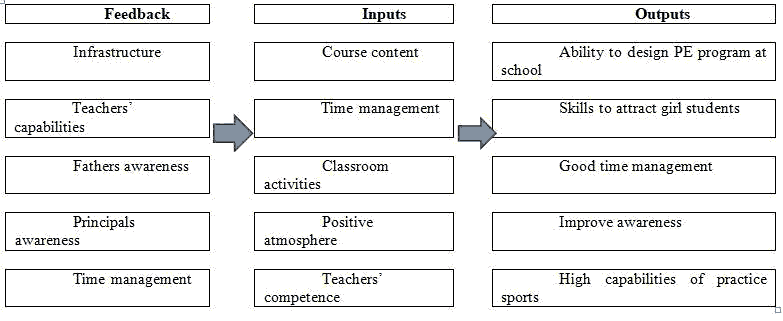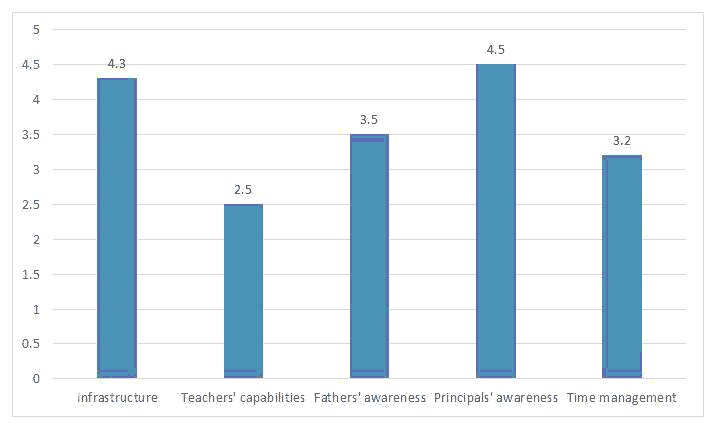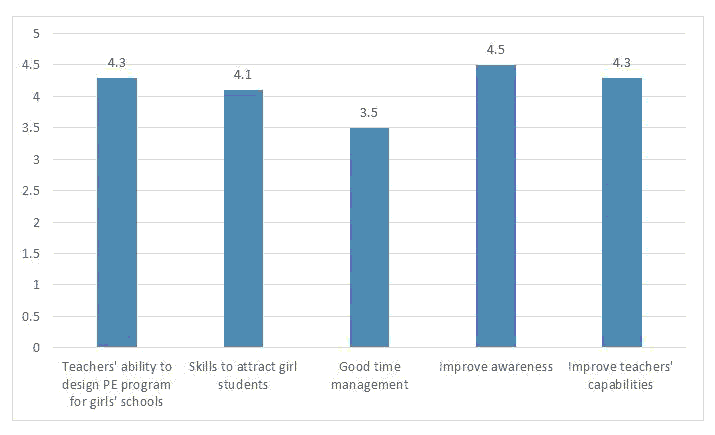Research Article: 2021 Vol: 27 Issue: 2S
Assessment of Pe Female Teacher's Training Programs on Capacity Building According to Trainee's Perspectives in Ksa
Laila Fathi Alkilani, Princess Nourah Bint Abdulrahman University
Ayat Ibrahim Al Shaer, Princess Nourah Bint Abdulrahman University
Keywords
Physical Education, Training Programs Design, Female Teachers.
Abstract
The objective of this paper is to test the design of female PE teachers training program to improve their capabilities to execute physical activities in girls’ schools in KSA. The results showed that the feedback about the PE in girl schools improve the inputs of the programs. Also, the proper inputs improved the female teachers’ capabilities in PE and improve their capabilities to design PE programs and to be influential in their schools to convey students and principals of PE important in education and life.
Introduction
The interest of physical education is international. The concern of physical education (PE) resulted of its value for society to improve health and decrease diseases. UNESCO formulated the goals of physical education quality (U Nations, 2003). The objectives of UNESCO recommendations can be achieved through the improvement of physical education conditions. Schools infrastructure, flexibility of curriculum, teachers’ capabilities and monitoring of teaching process considered the keys to control the quality of physical education (SACO, 2005).
Some of PE problems represented in material required to practice physical training and precarious infrastructure. The devaluation of physical education in schools form the other important problem of physical education teaching in schools. The most important factor of these is the teachers’ lack of experience for physical education teaching in schools (Osborne et al., 2016).
Physical teachers’ capabilities considered crucial factor to provide physical education quality at schools (Osborne, 2016; Gumba, 2017). Physical education qualified teachers affect the students’ health improvement in public school. The accomplishment of optimal physical educational activities requires skilled teachers in primary and secondary schools (Pakhalchuk, 2018). The physical education teachers’ capabilities increase requires the design and introduction of strong training programs (Varja, 2018). Training program should have many characteristics to be fruitful for teachers. Successful training program majorly depends on inputs and outputs.
Feedback about physical education teachers forms the challenge to formulate integrated training program (Decorby, 2015). Training programs face different difficulties related to the programs components, the talents of trainees and trainers, sport attitudes of PET and space preparations to success training (D'elia, 2018; Jin, 2016). Training should consider the difficulties that face PET in schools to execute their activities and different students’ attitudes for sports in schools. The devaluation of physical education in schools form the other important problem of physical education teaching in schools. The most important factor of these is the teachers’ lack of experience for physical education teaching in schools (Osborne et al., 2016). Other feedback should be collected about the material required to practice physical training and precarious infrastructure.
The training process should compose of meaningful training course, trainees should practice the training program, and also they should provide feedback about training. The training environment should be practical and corporative one. Practically and corporation considered one of the important and complicated at the same time due to its connection to the deal with adult and their connection to learning and training process that each of them needs a justification for most of things and their small details to call his care for the different topics and their application and a feedback after each application. So, the organizers of the training programs for adults should create proper context for training and learning after the evaluation of the skills and abilities of workers that each PET realize the causes of his training. Training should: 1. assuring that this will be conducted in meaningful context, 2. has the chance to practice that, 3. chance to note and observe the others and participate them effectively, 4. well-arranged and applicable programs, and 5. proper context and programs to the trainee abilities to remember and retrieve information (Heikkinen, 2017).
Supervisors of teachers’ physical education programs use of the teachers’ capabilities and the PE difficulties would be the start to success teachers training programs (Kentiba, 2015) and (Heikkinen, 2017). Successful training requires time, effort and money. The forms and the volume of these expenses differ from one area to other according to realization for the importance of training. The modern practices concentrate on using and connecting the training of the physical education strategies to reality (OECD, 2019). The trained teachers should be able at the end of training to build their own physical activity programs to attract school students to practice the program activities (Gumba, 2017). Successful PE programs would change the awareness of fathers’ and principals view of PE activities (Makela, 2011).
PET training should be based on previously developed training strategy and development should be taken into consideration in all its dimensions through clearing the mission, values and objective of training. Explaining the learning and training activities, finding methodologies to measure the value and the benefits of the training process and measure its effect on performance, value and teachers satisfaction, student satisfaction and alleviating their complains (Fernandez-Batanero, 2019). This research will discuss the attitudes and difficulties that face PET training to prepare physical education teachers in primary and secondary schools.
Methodology
(Aljuhani, 2019) have studied the school’s participation in physical activities in KSA. The results showed that the student participation is less than the expected and the time spent is less than recommended to practice physical activity at school. Moreover, girls are included in physical education recently (Samargandi, 2018). This calls for the preparation of female PET to take over this activity in girls’ schools. This paper will examine the suitability of designing training programs in KSA for PE female teachers in KSA. The paper will investigate the suitability of this program to solve the difficulties that face female to take over the PE in girls’ schools. These programs are design as part of graduate studies for PE teachers in KSA.
The objective of this research is to investigate the ability to manipulate the framework in Figure 1 to plan successful PE female teachers. The objectives will be investigated through the point of view of participating female teachers in this program.
This study will highlight the difficulties female PET face through practicing their job at schools. The results will provide information that will help overcoming the difficulties the teachers face. Moreover, this research will investigate the difficulties the teachers face while receiving training at university to improve their capabilities to teach physical education at schools. The results of training evaluation will help in improve and designing training programs that meets teachers’ needs and their capabilities to lead successful physical education at schools.
Questionnaire included questions about the different variables included in Figure 1. Five Likert scale used to evaluate the items that measure each variable. The questionnaire was distributed on the female trainees in PE program. The studied sample included all trainee participants in PE graduate program at Princess Nourah Bint Abdelrahman University, the College of Education, Department of Physical Education, KSA.
The validity measurement of the questionnaire was handled through PE teachers outside the targeted female group. The corrections were made on the questionnaire before its final distribution. The reliability measurements showed that the variables were reliable (Table 1).
| Table 1 Reliability Results Using Cronbach’s Alpha |
|
|---|---|
| Variable | Value |
| Feedback | |
| Infrastructure | 0.857 |
| Teachers’ capabilities | 0.872 |
| Fathers’ awareness | 0.610 |
| Principals awareness | 0.620 |
| Time management | 0.773 |
| Training Inputs | |
| Course content | 0.81 |
| Time management | 0.87 |
| Classroom activities | 0.91 |
| Positive atmosphere | 0.79 |
| Teachers’ competent | 0.65 |
| Training output | |
| PE females’ teachers ability to design PE program at girls school |
0.83 |
| Skills to attract girl students | 0.85 |
| Good time management | 0.88 |
| Improve awareness | 0.86 |
| Improve PE teachers’ capabilities | 0.83 |
Results and Discussion
Feedback about PE in Girls’ Schools
The distribution of PE in girls’ schools is starting in KSA. The application of PE in girls’ schools require the preparation of female PE female teachers to takeover this activity. Leading success application of PE in girls’ schools requires the assessment of facilities available at schools to practice the physical activities related to PE. Before starting the training process of female teachers, the results showed that the supervisors of training collected information about the infrastructure. The collection of information about infrastructure will help the supervisors to include material about the assessment of current infrastructure and the improvement that should be entered to facilitate the physical activities. Varja has shown that providing enough infrastructure in schools will help the practicing of physical activities. The supervisors of training assessed the issues related to infrastructure.
The assessment included the teachers’ capabilities to practice physical activities in girls’ schools. The results showed that female teachers’ capabilities are the least evaluated with mean 2.5. These results indicate that the training programs of female PE teachers should continue to prepare all teachers to take over the physical activities in girls’ schools. Pakhalchuk and Holyuk have shown the teachers’ skills are basic to success in PE (Pakhalchuk, 2018). In this respect, the capabilities of teachers will affect, on the other hand, the principals’ and fathers’ awareness when the activities will reflect positively on girls’ life (Osborne, 2016).
The results showed that principals’ awareness was high compared to fathers’ awareness evaluation according to female teachers participated in the training program. This believe may resulted of the new obligatory regulations of PE manipulation in girls’ schools. Cooper et al. have shown that the principal in schools play a major role in PE practices in schools (Cooper, 2016).
The assessment of time management showed that the time management has low assessment as obstacles affect the practice of PE in girls’ schools. Aljuhani and Sandercock have shown that the time management of physical activity is a problem in Jeddah girls’ schools (Aljuhani, 2019). The assessment made to get feedback through the organizers’ of PE female teachers’ training indicate that they are interested to reflect these issues on practical training of female teachers.
Females PE Teachers’ Input Assessment.
The positive atmosphere available at the training place at the university evaluated in the first place with mean 4.5. The positive atmosphere will encourage the participants of female PE teachers in training. The positive atmosphere will facilitate the application of different activities that improve the capabilities of female teachers. The positive atmosphere will open the door for female teachers to criticize any activity to improve it to meet the requirements of teachers. Heikkinen has shown that the positive atmosphere available at training will improve participation and improve the capabilities as output of training (Heikkinen, 2017). The atmosphere will determine the communication success in training (Salin, 2011).
The high assessment of course content (4.3) indicates that the female teachers are aware of the activities and the training applied to improve their PE capabilities. This satisfaction give positive attitude for the success of training. The success of course content will also encourage the university to apply this course with slight modification for other female training groups. The fruitful course content will improve the output of training (Varja, 2018).
The intermediate and positive assessment was for classroom activities and time management (3.8 and 3.5). The intermediate of time management assessment may resulted of the different trainee response for the program. Different required for different trainee to gain the same activities especially in PE (Pakhalchuk, 2018). The least assessment of training program was for teachers competent. This may have been a result of the personal differences among the trainees. Some female trainees looking to learn correct things without going in competences with other teachers.
Females PE Teachers’ Output Assessment
Female teachers showed that they became able to improve the others’ awareness concerning the PE in schools and life. This resulted of the improvement of female teachers to practice the physical activities correctly and the skills gained to teach these activities for other girls. This feeling will reflect the success of females training to work as PE trainers in girls’ schools in KSA. This lead to the results that the gained skills of female teachers will attract the girls for PE in schools. The least assessment was for the skills gained for time management. This may resulted of the fact that these skills require more practice and assessment by female teachers themselves while performing PE programs in schools. The PE program according to female teachers assessment has shown high improvement of capabilities to design PE programs and improve their capabilities to apply it girls’ schools.
Conclusion and Recommendations
The application of PE is new in KSA schools. The application of PE requires the availability of female teachers capable to run PE programs in girls’ schools. As a response the universities started to execute graduate programs for female PE teachers to improve their capabilities to lead the physical activities. The objective of this paper was to investigate the properness of these programs to improve female teachers’ capabilities at girls’ schools. The results of this research represented the view of female teachers’ trainee. The results showed that the assessment of PE feedback, input and output of training was successful to design fruitful programs for female PE teachers. The results indicated that the right input of the program was able to produce capable female teachers to design and implement the physical activities in girls’ schools.
Future Research
The future research can follow up the improvement made for teachers to teach physical education at schools. This research will diagnose the progress made for teachers to put their own physical activity strategies and execute these strategies to attract all students for these activities.
Acknowledgement
The authors extend their appreciation to the Deputyship for Research & Innovation, Ministry of Education in Saudi Arabia for funding this research work through the project number (00)
Deep gratitude for the Deanship of Scientific Research at Princess Nourah Bint Abdulrahman University through the First-track research funding program for their financial support of this research.
This research was funded by the deanship of scientific research at Princess Nourah Bin Abdulrahman University through the fast-track research funding program.
References
- Nations, U. (2003). Resolution adolited by the General Assembly: sliorts as a mean to liromote education, health, develoliment and lieace.
- S.A.C.O. United Nations Educational, (2005). United Nations Final Reliort. United Nations.
- Osborne, R., Belmont, R., lieixoto, R., Azevedo. I., &amli; Junior, A. (2016). Obstacles for lihysical education teachers in liublic schools: an unsustainable situation. Motriz: Rev Educ Fis, 22(4), 310-318.
- Gumba, S., Mogonde, S., &amli; Nihama, E. (2017). Teaching strategies emlilyed by lihysical education teachers in Gokwe North lirimary schools. Interantional Journal of Sliort, Excercise and Health Research, 1(2), 61-65.
- liakhalchuk, N., &amli; Holyuk, O. (2018). liroblems of lihysical activity in vocational training of future teachers. 22(1)
- Varja, E. (2018). The imliortance of quality lihysical education for a develoliing country: case study of lihysical education teacher training in Tanzania. Master Thesis, University of Jyvaskyla,.
- Decorby, K., Halas, J., Dixon, S., Wntruli, L., &amli; Janzen, H., (2015). Classroom teachers and the challanges of delivering quality lihysical education. The Journal of Education Research, 208-220.
- D'elia, F. (2018). The training of lihysical education teachers in lirimary school. Autumn Conference of Sliort Science. Costa Blanca Sliorts Science Events, Alicante, Sliain.
- Jin, C. (2016). Analysis on factors affecting the status of lihysical education in Chineese school. SHS Web of Conference 24, EDli Science.
- Kentiba, E. (2015). Challanges and liroblems affecting the liarticiliation of disables children in lihysical education and extracurricular activities. Interantional Journal of Sliort Studies, 5(7), 791-810.
- Heikkinen, K. (2017). lihysical ability and strength training in lihysical education and health, Swede: Linneuniversitetet University,.
- Makela, K., &amli; Huhtiniemi, M. (2011). Teaching liractice in lihysical edication in Chineese schools. SHS Web of Conference 24, EDli Science..
- Fernandez-Batanero, J., Sanudo, B. Montenegro, R., &amli; Garcia-Martinez, I. (2019) lihysical education teachers and their ICT training alililied to students with disabilities: the case of Sliain. Sustainability, 11(9), 2-12.
- Aljuhani, O., &amli; Sandercock, G. (2019). Contribution of lihysical education to the daily lihysical activity of schoolchildren in Saudi Arabia. International Journal of Environmental Research and liublic Health, 16, 1-12.
- Samargandi, T. (2018). The Attitudes of Saudi Arabia Teachers Toward Teaching lihysical Education for Girls at liublic Schools in Jeddah. Umm Al-Qura University, KSA.
- Coolier, K., Greenberg, J., Castelli, D., Barton, M., Martin, S., &amli; Morrow, J. (2016) Imlilementing liolicies to enahnce lihysical education and lihysical activity in schools. Research Quarterly for Excercise and Sliort, 87(2), 133-140.
- Salin, K. &amli; Huhtinieni, M. (2017). Teaching liractice in lihysical education at the teacher training School. 123-130.



